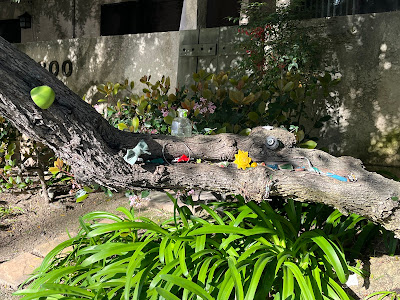A gas mask on top of a dead tree. Photo credit Anadolu/Getty Images. Downloaded from The Guardian.com
I was reading the article "Must landscapes mean? (by Marc Treib-1995, Theory of Landscape architecture) when I came across with this photo (above) on the Guardian.co, that impacted me so much. In my understanding, we may have a free interpretation of its meaning, who knows, maybe it was just a casual idea, but who can take away the explicit (at least for me) horror of the war from this dead tree with the deadly mask on top? Doesn't it look like a humanized tree that has become an anonymous soldier?
From the article by Geoff Dyer: ‘A gas mask on a tree stopped me in my tracks – it shows the air itself can be toxic’
"In its uncanny way the gas mask humanises this tree in Ukraine, lending it an identity that is contrary to what happens whenever a human is obliged to wear one. Everyone, man or woman, attractive or unattractive, ends up looking the same. What we have here, then, is a highly individualised form of anonymity that is in keeping with one of the most solemnly familiar species of war memorialisation: the unknown warrior. This was instituted in Britain in 1920 in the stunned aftermath of the first world war during which time the experience of the warrior had begun to acquire a quality of passivity. By the end of the second world war combatants and civilians alike shared the helpless experience of enduring bombardment, either from the air, by planes or by land from artillery. So the unknown figure of the wars of the 20th century and, of course, those now under way in Ukraine and Gaza, might well be the unknown non-combatant. Through no fault of their own, men, women and children become caught up in something dreadful, as might happen to a tree. A further layer of anonymity or unknown-ness is provided by the caption which identifies the agency but not the photographer who actually took this remarkable picture."
Coming back to Marc Treib's article, he explains how professionals from different fields of expertise, imbue meaning to landscape: "Cultural geographers, calling a collective body of study (...) interpret ordinary landscapes by first looking at the world around them; in their eyes, meaning congeals in setting, dwelling and use- and not alone from the designer's intention. Historians of gardens and landscape architecture tell us of those makers of places past who tried earnestly to create landscapes in which meaning would be apparent and understood (....) to convey to the visitor a message as well as a sensuous impression".
But this is all on the basis of users and designers sharing a similar cultural and social background. Hence, the communication (and significance) is achieved. He then explains that when people do not understand the meaning given by the maker (designer, architect) then there is no meaning because of lack of communication. In consequence "a plastic or metal plaque normally provides its meaning to the residents with credits to the designer (...)"
The Anadolu's photo obviously does not need further explanation, and it deeply moves me like a piece of art.
A tree "intervention". Photo by Myriam Mahiques, personal archives, 2024.
Among the different styles that Treib mentions as forms of giving meaning to landscape, there is the vernacular arrangement (I'm avoiding the word design) which typical example would be the concrete frogs, gnomes, that we must have seen in many houses. Taken away from their context, in Treib's words "multiplied by the hundreds and painted gold, they are not longer the common vernacular element they once were, but fodder for High Style designers".
I am sharing here an example of vernacular "landscape ornaments" on a tree branch. This is very close to where I live and I'm following up the minor changes. I am assuming this tree branch appropriation is done by a child, but again, who can tell? Should I intellectualize the arrangement? I could, but I prefer to enjoy this fresh, innocent intervention, that gives me food for thought every time I walk along this building. And repeating Treib's question, do we need to have a meaning for this? I suppose not, I am just happy with the feeling it produces in me, the surprise, the fun, the curiosity.....
The following pictures were taken in April 2024 and are part of my personal archives.











No comments:
Post a Comment